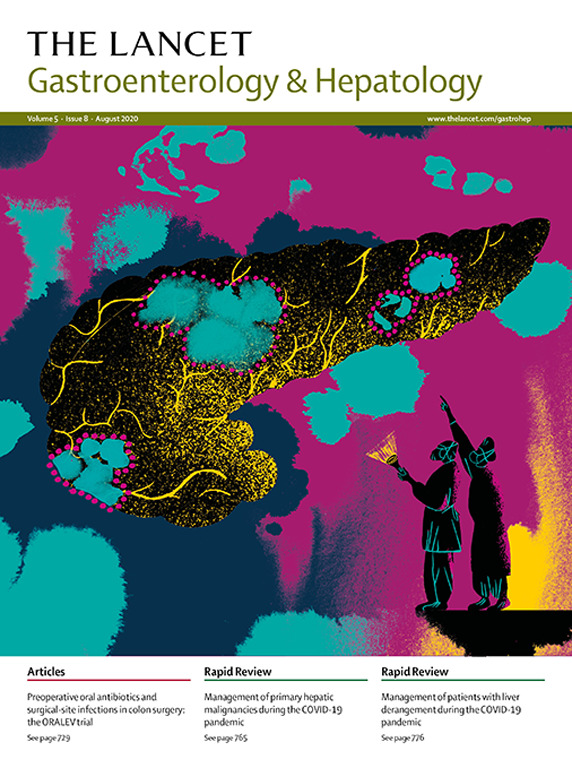Spleen stiffness measurement by vibration-controlled transient elastography at 100 Hz for non-invasive predicted diagnosis of clinically significant portal hypertension in patients with compensated advanced chronic liver disease: a modelling study.
IF 30.9
1区 医学
Q1 GASTROENTEROLOGY & HEPATOLOGY
引用次数: 0
Abstract
BACKGROUND In patients with compensated advanced chronic liver disease (cACLD), risk of clinically significant portal hypertension (CSPH) can be estimated by applying non-invasive tests such as liver stiffness measurement (LSM), platelet count, and, in some cases, BMI. We aimed to assess the diagnostic utility of spleen stiffness measurement (SSM) at 100 Hz as a standalone non-invasive test for CSPH and to evaluate its incremental value compared with the ANTICIPATE±NASH model in patients with cACLD. METHODS For this modelling study, patients were recruited from 16 expert centres in Europe. Patients who underwent characterisation by hepatic venous pressure gradient (HVPG) and non-invasive tests (ie, LSM, platelet count, and SSM at 100 Hz) at one of the participating centres between Jan 1, 2020, and Dec 31, 2023, were considered for inclusion. Only patients aged 18 years or older with Child-Pugh class A cACLD, shown by LSM 10 kPa or more or F3 or F4 fibrosis on liver histology, were included. The overall cohort was split into the derivation cohort (patients recruited between Jan 1, 2020, and Dec 31, 2022) and the temporal validation cohort (patients recruited between Jan 1, 2023, and Dec 31, 2023). The ANTICIPATE±NASH model was applied to assess individual CSPH probability and SSM was investigated as a standalone non-invasive test for CPSH; in combination with platelet count and BMI; and in a full model of SSM, LSM, platelet count, and BMI (ie, the Non-Invasive CSPH Estimated Risk [NICER] model). All models were binary logistic regression models. The primary outcome was CSPH. We evaluated the discriminative utility of the models by calculating the area under the receiver operating characteristics curve (AUC) and creating calibration plots and calibration of intercept, slope, and integrated calibration index. FINDINGS 407 patients with cACLD were included, 202 (50%) in the derivation cohort and 205 (50%) in the validation cohort. Median age was 60·0 years (IQR 55·0-66·8); 275 (68%) of 407 patients were male and 132 (32%) were female. 164 (40%) of 407 patients had metabolic dysfunction-associated steatotic liver disease (MASLD), 133 (33%) had MASLD with increased alcohol intake or alcohol-related liver disease, 75 (18%) had viral hepatitis (61 [81%] of whom had sustained virologic response of hepatitis C virus or suppression of hepatitis B virus DNA), and 35 (9%) had other chronic liver diseases. 241 (59%) patients had CSPH. Median SSM was 45·0 kPa (32·1-65·4) and LSM was 21·4 kPa (14·1-31·6). SSM and LSM had similar AUCs for prediction of CSPH in the derivation cohort (0·779 [95% CI 0·717-0·842] vs 0·781 [0·718-0·844]; p=0·97) and in the validation cohort (0·830 [0·772-0·887] vs 0·804 [0·743-0·864]; p=0·50). The SSM-based model comprising platelet count and BMI had a similar AUC as the ANTICIPATE±NASH model in both the derivation cohort (0·849 [0·794-0·903] vs 0·849 [0·794-0·903]; p=0·999) and in the validation cohort (0·873 [0·819-0·922] vs 0·863 [0·810-0·916]; p=0·75). The NICER model had a significantly higher AUC for prediction of CSPH than the ANTICIPATE±NASH model in the derivation cohort (0·889 [0·843-0·934] vs 0·849 [0·794-0·903]; p=0·022) and in the validation cohort (0·906 [0·864-0·946] vs 0·863 [0·810-0·916]; p=0·012). INTERPRETATION The addition of SSM to LSM, BMI, and platelet count outperformed the ANTICIPATE±NASH model for CSPH risk stratification in our cohort of contemporary patients with cACLD. SSM improves the non-invasive diagnosis of CSPH, supporting its implementation into clinical practice. FUNDING Echosens.通过 100 Hz 振动控制瞬态弹性成像技术测量脾脏硬度,用于无创预测诊断代偿期晚期慢性肝病患者具有临床意义的门静脉高压症:一项模型研究。
背景在代偿性晚期慢性肝病(cACLD)患者中,临床意义门静脉高压症(CSPH)的风险可通过肝脏僵硬度测量(LSM)、血小板计数等无创检验进行估计,在某些情况下还可通过体重指数(BMI)进行估计。我们的目的是评估 100 Hz 脾脏僵硬度测量 (SSM) 作为 CSPH 独立无创检验的诊断效用,并评估其在 cACLD 患者中与 ANTICIPATE±NASH 模型相比的增量价值。在 2020 年 1 月 1 日至 2023 年 12 月 31 日期间,在其中一个参与中心通过肝静脉压力梯度(HVPG)和非侵入性测试(即 LSM、血小板计数和 100 Hz 的 SSM)对患者进行特征描述的患者被视为纳入对象。只有年龄在18岁或18岁以上、Child-Pugh A级cACLD(LSM 10 kPa或以上或肝组织学显示F3或F4纤维化)患者才被纳入。总体队列分为衍生队列(2020 年 1 月 1 日至 2022 年 12 月 31 日期间招募的患者)和时间验证队列(2023 年 1 月 1 日至 2023 年 12 月 31 日期间招募的患者)。ANTICIPATE±NASH 模型用于评估个体 CSPH 概率,SSM 作为 CPSH 的独立无创检验;与血小板计数和 BMI 结合;以及在 SSM、LSM、血小板计数和 BMI 的完整模型(即无创 CSPH 估计风险 [NICER] 模型)中进行了研究。所有模型均为二元逻辑回归模型。主要结果是 CSPH。我们通过计算接收者操作特征曲线下面积(AUC)和创建校准图以及校准截距、斜率和综合校准指数来评估模型的判别效用。中位年龄为60-0岁(IQR 55-0-66-8);407名患者中有275名(68%)为男性,132名(32%)为女性。407名患者中有164人(40%)患有代谢功能障碍相关性脂肪性肝病(MASLD),133人(33%)患有代谢功能障碍相关性脂肪性肝病并伴有酒精摄入量增加或酒精相关性肝病,75人(18%)患有病毒性肝炎(其中61人[81%]具有丙型肝炎病毒持续病毒学应答或乙型肝炎病毒DNA抑制),35人(9%)患有其他慢性肝病。241(59%)名患者患有 CSPH。中位 SSM 为 45-0 kPa(32-1-65-4),LSM 为 21-4 kPa(14-1-31-6)。在衍生队列(0-779 [95% CI 0-717-0-842] vs 0-781 [0-718-0-844]; p=0-97)和验证队列(0-830 [0-772-0-887] vs 0-804 [0-743-0-864]; p=0-50)中,SSM 和 LSM 预测 CSPH 的 AUC 相似。在衍生队列(0-849 [0-794-0-903] vs 0-849 [0-794-0-903];p=0-999)和验证队列(0-873 [0-819-0-922] vs 0-863 [0-810-0-916];p=0-75)中,由血小板计数和体重指数组成的基于 SSM 的模型的 AUC 与 ANTICIPATE±NASH 模型相似。在衍生队列(0-889 [0-843-0-934] vs 0-849 [0-794-0-903];p=0-022)和验证队列(0-906 [0-864-0-946] vs 0-863 [0-810-0-916];p=0-012)中,NICER 模型预测 CSPH 的 AUC 明显高于 ANTICIPATE±NASH 模型。在我们的当代 cACLD 患者队列中,在 LSM、BMI 和血小板计数的基础上增加 SSM 进行 CSPH 风险分层的效果优于 ANTICIPATE±NASH 模型。SSM改进了CSPH的无创诊断,支持将其应用于临床实践。
本文章由计算机程序翻译,如有差异,请以英文原文为准。
求助全文
约1分钟内获得全文
求助全文
来源期刊

Lancet Gastroenterology & Hepatology
Medicine-Hepatology
CiteScore
50.30
自引率
1.10%
发文量
0
期刊介绍:
The Lancet Gastroenterology & Hepatology is an authoritative forum for key opinion leaders across medicine, government, and health systems to influence clinical practice, explore global policy, and inform constructive, positive change worldwide.
The Lancet Gastroenterology & Hepatology publishes papers that reflect the rich variety of ongoing clinical research in these fields, especially in the areas of inflammatory bowel diseases, NAFLD and NASH, functional gastrointestinal disorders, digestive cancers, and viral hepatitis.
 求助内容:
求助内容: 应助结果提醒方式:
应助结果提醒方式:


